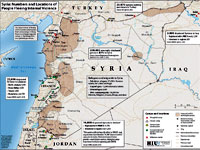Antony Penaud: How the Economist changed its map of the Syrian conflict to make it look like Russia is bombing moderate rebels rather than al-Nusra

Subject: How the Economist changed its map of the Syrian conflict to make it look like Russia is bombing moderate rebels rather than al-Nusra
Date: Thu, 8 Oct 2015
From: Antony Penaud <antonypenaud@yahoo.fr>
Antony Penaud completed his DPhil at the University of Oxford in 2000. His essays on Russia and Ukraine are on www/scribd.com/antonykharms. He is French and lives in London.
Russia started airstrikes in Syria on 30 September 2015 and has been accused by Western media and governments to target the rebels (portrayed as moderates) rather than the Islamic State.
The Economist published a map (1) of the airstrikes, as well as the areas controlled by the Islamic State, the Government, the Kurds and the Rebels.
On that map, 25 targets for the airstrikes are shown (it is not clear how many strikes correspond to each target).
7 targets fall in areas controlled by the Islamic State
2 targets fall in areas controlled by the Government.
16 targets fall in areas controlled by the Rebels.
However, a few days before the beginning of the strikes (on 26 September), the Economist published another map of the situation in Syria (2).
On that map, the areas controlled by al-Nusra (al Qaeda) were shown too (in the more recent map al-Nusra is not mentioned at all and the al-Nusra areas are controlled by the Rebels).
If we compare the areas of the Russian targets to the 26 September map, we see that out of the 16 strikes that fell in the Rebels controlled areas, 9 fell in al-Nusra controlled areas (3).
So, we now have 7 targets in Islamic State areas, 9 targets in al-Nusra areas, 2 targets in Government areas, and 7 targets in Rebels (as defined by the Economist before the Russian airstrikes) areas.
Furthermore, on 22 September Russian media reported the execution of gay men by the Islamic State (4).
Some of these executions took place in Rastan, just North of Homs.
According to both maps from the Economist, the Islamic State doesn’t control any area near Rastan, and these areas are controlled by the Rebels and the Government.
Assuming that it is the 22 September news that is correct and looking at the targets’ map, we reallocate the 2 Government targets against to the Islamic State, and 2 Rebels targets to the Islamic State.
We now have 11 targets in Islamic State areas, 9 targets in al-Nusra areas, and 5 targets in Rebels (as defined by the Economist before the Russian airstrikes) areas.
The 5 remaining targets in Rebels’ areas are the ones in the North West of Syria.
According to Robert Fisk (5), “The first strikes – far from being aimed at the ‘moderates’ whom the US had long ago dismissed – were directed at the large number of Turkmen villages in the far north-west of Syria which have for many months been occupied by hundreds of Chechen fighters – the very same Chechens whom Putin had been trying to liquidate in Chechnya itself. These Chechen forces assaulted and destroyed Syria’s strategic hilltop military Position 451 north of Latakia last year. No wonder Bashar’s army put them on the target list. Other strikes were directed not at Isis but at Islamist Jaish al-Shams force targets in the same area.”
So, finally, we have 11 targets in Islamic State areas, 9 targets in al-Nusra (al Qaeda) areas, and 5 targets in Chechen fighters/Jaish al-Sham areas.
In his article, Fisk (who is no friend of Assad or Putin), shows there are no moderates fighting in Syria: just different jihadist groups (and Kurds, and the Syrian army).
Following the Russian airstrikes, the Economist changed its map of the Syrian conflict: all of a sudden al-Nusra disappeared of the map.
In doing this, the Economist not only disrespected its readers by assuming they wouldn’t remember the map they were presented the week before, but also decided that al-Nusra (al-Qaeda) was part of the imaginary moderate rebels (“the opposition”) that the West (following Saudi Arabia, Qatar and Turkey) were supporting.
Portraying extremists as moderates in order to demonise Russia – one cannot help but see a parallel with another crisis (6).
(1) https://espresso.economist.com/0511c74339446a24dd942bd10ec7581a
(2) http://www.economist.com/news/middle-east-and-africa/21667947-russias-intervention-side-bashar-assad-just-might-increase-chances
(3) The airstrikes in between Idlib and Hama on the more recent map.
(4) https://news.vice.com/article/the-islamic-state-executes-9-men-and-a-boy-for-being-gay
(5) http://www.independent.co.uk/voices/syria-s-moderates-have-disappeared-and-there-are-no-good-guys-a6679406.html
(6) http://www.dailymail.co.uk/news/article-3073478/Teen-girl-feted-Ukraine-s-Joan-Arc-fighting-against-Russian-rebels-revealed-nasty-neo-Nazi-views-arrested-killing-cops.html
